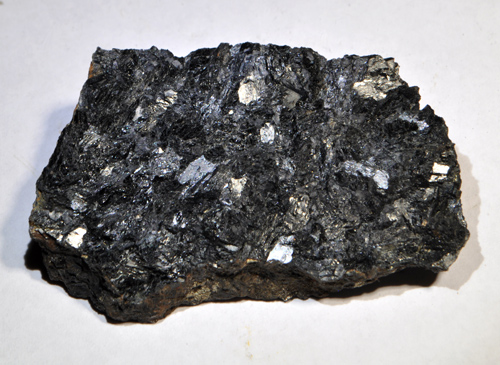The hastingsite Mineral Group

Hastingsite is a member of the extended Hornblende group. There are
several variations of Hastingsite with different elemental
substitutions. Some of these are recognized as individual minerals,
thereby making Hastingsite a mineral group, with Hastingsite the
dominating member. Hastingsite is named after Hastings Co. in Ontario, which is the type locality for this mineral.
Chemical Formula
NaCa2Fe2+3Fe3+4Al2Si6O22(OH)2
Color
Black, gray, dark green, beige, tan, brown
Crystal System
Monoclinic
Properties
Streak
Light gray with a greenish tinge |
Hardness
5 - 6 |
Transparency
Translucent to opaque |
Specific Gravity
3.2 - 3.6 |
Luster
Vitreous, submetallic, dull |
Cleavage
1,2 - prismatic |
Fracture
Uneven |
Tenacity
Brittle |
Varieties
Hastingsite is the name of an individual mineral, as well as group name
for several similar Hastingsite-related minerals with slight variations of
elements in their chemical formula. The main variety is magenesio-hastingsite, but there are several other rare combinations defined by the IMA as individual minerals with potassium, fluorine, and chlorine. These rare varieties are not listed here.
-
Variety of Hastingsite where magnesium partially replaces the iron where the magnesium is more dominant. Magnesio-hastingsite is recognized by the IMA as a distinct mineral
species with the following chemical
formula: NaCa2Mg4Fe3+Al2Si6O22(OH)2
Noteworthy Localities
Hastingsite is fairly common, though often perceived as Hornblende and not further identified. It generally does not make aesthetic mineral specimens, and is not commonly represented in collections. Thus, only few localities are mentioned here. The type locality of Hastingsite, where it forms in stubby crystals, is Dungannon Township, Hastings Co., Ontario, Canada. Hastingsite is very prevalent as black crystallized plates throughout the old iron mines of the Hudson Highlands and Ramapo Mountains, Rockland and Orange Counties, New York; and across the border in Passaic County, New Jersey. Large crystal plates were found in the iron mines of Monroe, Orange Co., New York; and dark gray crystals at the Sterling Hill Mine, Ogdensburg, New Jersey.
A new discovery in 2013 on the Rhein Property in Amity, Orange Co., New York has yielded some exceptionally large and sharp crystals of
Magnesio-hastingsite, associated with red
Spinel, embedded
Graphite, and an occasional Geikielite crystal. Originally mistaken for
Fluoro-pargasite, these have been reanalyzed as Magnesio-hastingsite and are by far the best examples of this mineral.
Distingushing Similar Minerals
Hastingsite can be very difficult to distinguish from other Hornblendes, though a locality will often be able to isolate it.